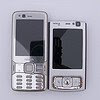This
NECC 2009 session was presented by
Gail Petri , a former school library media specialist, now an Educational Resources Specialist at the Library of Congress with Judith Graves, a former ESL teacher, now Digital Projects Coordinator at the Library of Congress. Here's the summary below:
Bring history alive for your students! Learn strategies and quick tips for accessing more than 13 million primary source treasures and teaching resources at http://www.loc.gov/.
What an absolutely amazing wealth of resources: books, manuscripts, maps, motion pictures, sheet music, sound sheets, photos, prints, sound recordings, and other printed texts. Current and archived
exhibitions,
American Memory,
World Digital Library,
Veterans History, and legislative information through
Thomas are the LOC's major sections. There are multiple ways to search for information, i.e. browse by topic, collection, time period, geographic location, or media type, as well as search terms. Ms. Petri recommended browsing rather than using search terms. The terminology and subject headings can be very specific so browsing helps you drill down in a search more easily.
2.jpg)
Ms Petri and Ms Graves guided us through the various sections and areas on the
homepage. I would highly recommend listening to the
video recording and following along with the powerpoint presentation slides located
here. Ms Petri has saved this presentation (GailLOCNavigating.ppt) and a couple others at
drop.io , a free site that can be used to share documents online. The powerpoints can be downloaded and used for your own presentations.
Along with the general resources are specially grouped resources for specific groups, i.e.
Kids and Families,
Teachers,
Librarians, and others. Tools are available that teachers can use to learn how to integrate primary documents into lessons.
Primary Resource Sets and
Collection Connections are just two of the specially grouped resources that are very useful for teachers. A brand new build-it-yourself professional-development tool for teachers called
TPS Direct was released during NECC 2009. Read more about it and the Teacher portal
here.
There are webcasts, podcasts also available via
iTunes U, a
blog, and
RSS . The Library of Congress can also be found on the Web via
Facebook,
Flickr,
Twitter, and
YouTube.
There are so many, many resources it's almost overwhelming. This presentation helps you get a grasp on how to use the Library of Congress. I also found this
tips handout.pdf about the Library of Congress. It's very handy to help you locate resources and includes the urls.
A few resources I especially liked are:
What do you find useful at the Library of Congress?
My next step is to check out TPS Direct, the build-it-yourself professional development.
.jpg)
Both photos have Creative Commons license's. The plaque was taken byJonathon
Colman and the photo above was taken by Michael
Kuroda.
Library of CongressLOCnecc2009digital resourcesTurbo Tagger
 Nominations for your favorite blogs close on Tuesday, December 8. Be sure to read about the two step process of nominating:
Nominations for your favorite blogs close on Tuesday, December 8. Be sure to read about the two step process of nominating:
 Though, not every session has a video, sometimes there's a url available with valuable resources or you can identify an expert that you can follow on Twitter and/or add a blog to your RSS reader.
Though, not every session has a video, sometimes there's a url available with valuable resources or you can identify an expert that you can follow on Twitter and/or add a blog to your RSS reader. 2.jpg)
.jpg)






 Now take a look. Below I chose novel style, medium size, and medium margins.
Now take a look. Below I chose novel style, medium size, and medium margins.


